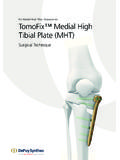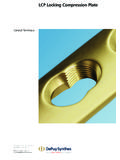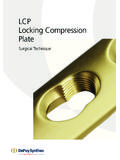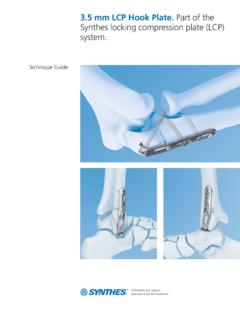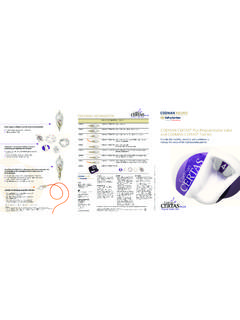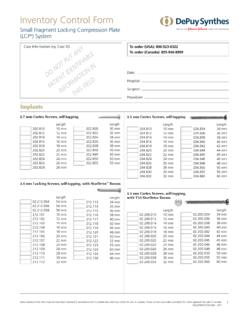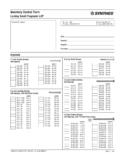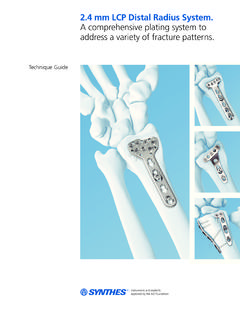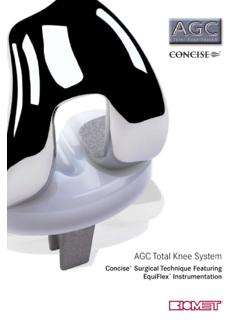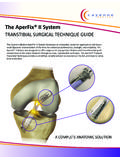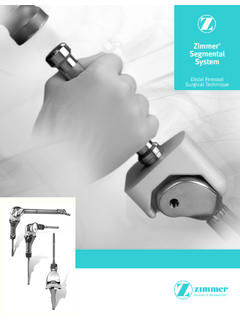Transcription of Expert R/AFN. Retrograde/Antegrade Femoral Nail.
1 EXPERTN ailing SystemExpert R/AFN. Retrograde/Antegrade Femoral TechniqueInstruments and implants approved by the AO publication is not intended for distribution in the intensifier controlThis description alone does not provide sufficient background for direct use of DePuy Synthes products. Instruction by a surgeon experienced in handling these products is highly , Reprocessing, Care and MaintenanceFor general guidelines, function control and dismantling of multi-part instruments, as well as processing guidelines for implants, please contact your local sales representative or refer to: general information about reprocessing, care and maintenance of Synthes reusable devices, instrument trays and cases, as well as processing of Synthes non-sterile implants, please consult the Important Information leaflet (SE_023827) or refer to.
2 Retrograde/Antegrade Femoral nail surgical technique DePuy Synthes 1 TABLE OF CONTENTSINTRODUCTION Expert R/AFN 4AO Principles 7 Indications and Contraindications 9 Cases 10 retrograde APPROACH Opening the Distal Femur 12 Reaming (Optional) 21 Inserting nail 22 Standard Locking 27 End Cap Insertion 32 Spiral Blade Locking (Optional) 33 End Cap Insertion 39 Freehand Locking 40 Interlocking with PAD for Expert RFN (Optional) 47 antegrade APPROACH Opening the Proximal Femur 52 Reaming (Optional) 61 Inserting nail 62 Standard Locking 66 End Cap Insertion 67 Freehand Locking 692 DePuy Synthes Expert Retrograde/Antegrade Femoral nail surgical TechniqueTable of ContentsIMPLANT REMOVAL 70 PRODUCT INFORMATION Nails 75 Locking Implants 79 Instruments 83 Comparison Table 97 Handling Information 99 Modular Cases 101 Vario Case 105 Power Tools 107 Optional.
3 Angular Stable Locking System (ASLS) 108 MRI INFORMATION 1104 DePuy Synthes Expert Retrograde/Antegrade Femoral nail surgical TechniqueEXPERT R/AFNRETROGRADE/ antegrade Femoral nail DESIGNThe nail design offers great flexibility One system for retrograde and antegrade technique One system for left and right femur Anatomic bend for ease in insertion and extraction Cannulation of all nails for guided insertion in reamed and unreamed technique Large portfolio with nail diameters ranging from B to mm and lengths ranging from 160 to 480 mm Versatile locking configuration for static, dynamic, standard and spiral blade lockingretrogradeRFN, 160 200 mmstraightretrogradeRFN, 220 280 mmantecurvature 1500 mmretrogradeR/AFN, 300 480 mmantecurvature 1500 mmantegradeR/AFN, 300 480 mmantecurvature 1500 mm Expert Retrograde/Antegrade Femoral nail surgical technique DePuy Synthes 1 UNIQUE DISTAL LOCKING OPTIONS The unique distal combination hole facilitates locking for every anatomical situation and fracture type.
4 The sur-geon can intraoperatively choose between spiral blade locking (with one spiral blade and one locking screw) and standard locking (with two locking screws). The end cap with self-retaining Stardrive recess allows for angular stable locking of the most distal locking implant in both confi T40 This patient has some Synthes locking screws with hexalobular internal drive according to EN ISO 10664 Stardrive T25 This patient has some Synthes locking screws with hexalobular internal drive according to EN ISO 10664 6 DePuy Synthes Expert Retrograde/Antegrade Femoral nail surgical TechniqueEnd caps: Self-retaining Stardrive recess for effortless and secure end cap pick-up and insertion Possibility to block spiral blade or most distal (retro-grade) or most proximal locking screw ( antegrade ) for absolute angular stability End cap prevents ingrowth of tissue and facilitates nail removalLocking screws.
5 Double thread for more contact points leading to enhanced stability Thread closer to screw head facilitates bone purchase and improved stability Self-holding Stardrive recess for effortless and secure locking screw pick-up Titanium alloy TAN for improved mechanical and fatigue properties Adapted locking screw diameter to nail diameter: B mm for nails B mm B mm for nails B and mmSpiral blades: Facilitate hold in osteoporotic bone by increased surface area Angular stable locking by end cap Titanium alloy TAN for improved mechanical and fatigue propertiesIMPROVED STABILITYE xpert Femoral Retrograde/Antegrade Femoral nail surgical technique DePuy Synthes 7AO PRINCIPLES In 1958, the AO formulated four basic principles, which have become the guidelines for internal ,21 M ller ME, M Allg wer, R Schneider, H Willenegger.
6 Manual of Internal Fixation. 3rd ed. Berlin Heidelberg New York: Springer. 19912 R edi TP, RE Buckley, CG Moran. AO Principles of Fracture Management. 2nd ed. Stuttgart, New York: Thieme. 2007 Anatomic reductionFracture reduction and fixation to restore anatomical , active mobilizationEarly and safe mobilization and rehabilitation of the injured part and the patient as a fixationFracture fixation providing absolute or relative stability, as required by the patient, the injury, and the personality of the of blood supplyPreservation of the blood supply to soft tissues and bone by gentle reduction techniques and careful DePuy Synthes Expert Retrograde/Antegrade Femoral nail surgical TechniquePreservation of blood supplyWhen the canal is not reamed.
7 Intramedullary nailing generates minimal trauma to the endosteum and, there-fore, the blood supply is maximised through the unin-jured endosteum and periosteum. Reaming the canal temporarily disrupts the endosteal blood supply but probably stimulates the revascularisation and therefore the bone , active mobilisationIntramedullary nailing, combined with the AO technique , provides relatively stable fracture fixation with minimal trauma to vascular supply. This helps to create an improved environment for bone healing, accelerating the patient s return to previous mobility and PrinciplesExpert Retrograde/Antegrade Femoral nail surgical technique DePuy Synthes 9 Indications for retrograde approachIn retrograde approach, the Expert retrograde /Ante-grade Femoral nail is indicated for fractures in the distal femur: 33-A1/A2/A3 33-C1/C2 the 33-C fractures, the Expert Retrograde/Antegrade Femoral nail should be used in combination with other implants (not shown in the illustration).
8 Additionally, the Expert Retrograde/Antegrade Femoral nail is indicated for fractures in the Femoral shaft: 32-A/B/C (except 32-A[1-3].1 and 32-B[1-3].1 (subtrochanteric fractures)) in case of: combination with fractured patella ipsilateral femur/tibia fractures (floating knee) combination with fractured acetabulum, pelvis, or Femoral neck combinations of the fractures mentioned above pronounced adipositas pregnancy polytrauma (if numerous surgical teams are involved in treatment of patient)Note: In case of osteoporotic bone, it is strongly recommended to utilise spiral blade locking in the distal for antegrade approachIn antegrade approach, the Expert retrograde / antegrade Femoral nail is indicated for fractures in the Femoral shaft: 32-A/B/C (except 32-A[1-3].)
9 1 and 32-B[1-3].1 (subtrochanteric fractures))Note: ASLS, the Angular Stable Locking System, is indicated in cases where increased stability is needed, such as in fractures closer to the metaphy-seal area or in poor quality bone. For more details regarding the intramedullary fixator principle, please consult the ASLS surgical technique (DSEM/TRM/0115/0284). ContraindicationsNo specific AND CONTRAINDICATIONS11 DePuy Synthes Expert Retrograde/Antegrade Femoral nail surgical TechniqueCASESCase 1 retrograde approach standard lockingCase 1 retrograde approach standard lockingCase 3 antegrade approach standard lockingExpert Retrograde/Antegrade Femoral nail surgical technique DePuy Synthes 11 Case 1 Case 1 Case 3 preoperativepreoperativepreoperativepost operativepostoperativepostoperative12 DePuy Synthes Expert Retrograde/Antegrade Femoral nail surgical Technique1 Position patientPosition the patient supine on a radiolucent table.
10 The knee of the injured leg should be flexed 70 to 90 allowing for correct reduction of the fracture and locali-sation of the nail entry point. A leg roll may be used to allow proper reduction and stabilisation of the the image intensifier in such a way that visuali- sation of the femur including the proximal and distal ends is possible in AP and lateral contralateral leg should be flexed in the hip and in the knee and rested in an elevated position to enable visualisation by image fracturePerform closed reduction manually by axial traction under image intensifier. In case of older fractures, the use of the large distractor ( ) or pinless fixator ( ) may be appropriate under certain : Intra-articular fractures should be stabilized with interfragmentary screw fixation prior to inser-tion of the nail .
